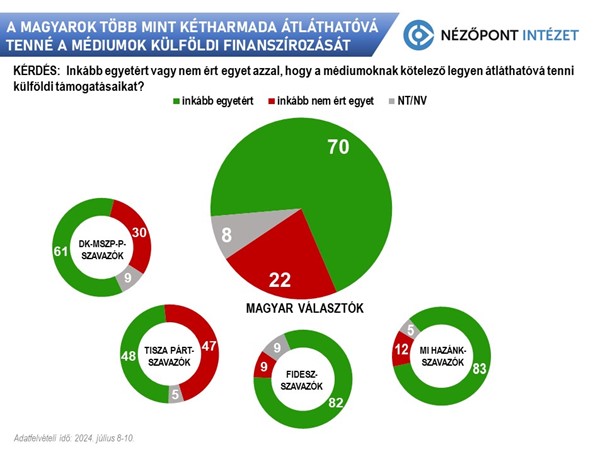There is broad (70 percent) public support for transparency in foreign funding of Hungarian media outlets. This view of more than two-thirds of Hungarians underpins the government’s efforts to fight against war propaganda by ensuring that the Hungarian media outlets disclose their foreign funding sources.
According to a representative public opinion poll conducted by the Nézőpont Institute in July, more than two-thirds of Hungarians support transparency regarding foreign funding received by Hungarian media outlets. 70 percent of Hungarians agree that the media should be obliged to be transparent about their foreign funding, while only 22 percent disagree. The strongest support for transparency comes from Fidesz and Mi Hazánk voters, but even the relative majority of Tisza voters, who appear to be the most critical, are in favour of transparency as well.

The relevance of this survey stems from the increasing attempts of foreign interference in Hungarian domestic politics, which understandably concerns the Hungarian public. These attempts of interference have intensified particularly after the outbreak of the Ukrainian-Russian armed conflict and are primarily aimed at changing the pro-peace stance of the Hungarian government through various means, including the financing of government critical actors.
The involvement of the organisation Action for Democracy in the 2022 election campaign drew attention to foreign fundings directed to opposition political actors in Hungary. This action alone brought HUF 1.9 billion of foreign support to the publisher of the extremely anti-government site ezalenyeg.hu, which legitimately raised the question of who and with what intentions are financing media outlets from abroad that are capable of influencing public opinion, and thus the will of the electorate.
Nézőpont’s annual analysis entitled ‘Freedom of the Press in Hungary 2023’, published in July, paid special attention to this phenomenon and found that the number and revenues of government critical media outlets are steadily increasing year by year. While these media outlets are overall profitable, their foreign funding remains opaque. Media publishers are not obliged to disclose this information, and in their annual reports these revenues are listed under “other income” or “subsidies”, but it is not possible to know the amount, the purpose of the subsidy, the donors or even whether these funds come from domestic or foreign sources.
The donor side also avoids transparency, as donors (be they foreign governments, foundations or professional umbrella organisations) do not always or not at all disclose the list of Hungarian beneficiaries. Furthermore, transparency is also hindered by the fact that donors often channel funds to Hungarian media through several international organisations, hiding behind chain financing. For instance, the Soros Foundation, which announced its withdrawal from Europe in 2023, continues to indirectly support government critical media outlets in Hungary through such collaborations.
The Nézőpont Institute drew attention to the fact that it could even pose an obvious (national) security risk if foreign actors tried to put pressure on the Hungarian government (and public opinion) to engage in war by financing government critical media outlets. In response, the government, in its resolution on the anti-war action plan, decided to introduce a legislation that requires the disclosure of foreign funding received by media outlets.
According to the opinion poll of the Nézőpont Institute, the overwhelming majority of Hungarians support this government initiative aimed at ensuring transparency.
Methodology
The latest opinion-poll of the Nézőpont Institute was conducted between 8 and 10 of July, 2024, by interviewing 1,000 respondents by phone. For all surveys, the sample is representative of the adult population (18 years and older) by gender, age, region, type of settlement and education. In case of a sample size of 1000 respondents and a confidence level of 95 percent, the margin of sampling error is ± 3.16 percent. Respondent base = Hungarian voters, respondents who are willing to participate in a national election.
